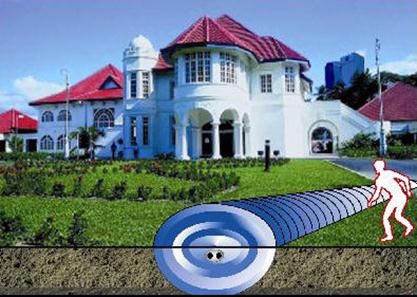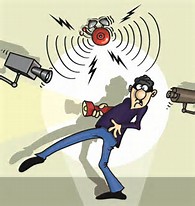
Every year homeowners and businesses in the United States spend more than 30 MILLION on various types of burglar and intrusion alarms. With technology moving forward at an unceasing pace, there are all kinds of new burglar intrusion alarms on the market but almost all burglar intrusion alarms can be classified as two types: Monitored systems & Un-monitored systems.
Monitored alarm systems alert a security call center if the alarm is triggered and the call center then reports the alarm activation to the police (or in some cases to private security officers) who respond to the scene.
Unmonitored systems set off ear-piercing whining sirens and/or bright flood lights when the alarm is tripped. These systems are designed to ‘wake up the neighborhood’ and scare the intruder away.
All of these burglar alarm systems work on four basic principles: Deterrence, Apprehension, Deterrence and Loss Mitigation, and  Deterrence and apprehension.
Deterrence and apprehension.
- Deterrence. The presence of a burglar alarm acts as a deterrent.
There is a body of academic research, and certainly anecdotal evidence, that burglar alarms do have a genuine deterrent effect. Most burglars are lazy. And, despite many burglars suffering from diminished mental faculties due to prolonged drug use (or just not being all that bright in the first place) every burglar I have ever met (and in my 34 years of law enforcement I met plenty) would prefer not to get caught. If they have the choice of breaking into a home or building that they know has a burglar alarm or a home or business without one, they will almost always target the one without any alarm system.
- Apprehension. Some alarms are designed to notify authorities of an intrusion in the belief that authorities can arrive in time to capture the intruder.
When I first started in police work we responded to every report of a burglar alarm being triggered. Response time was usually reasonably prompt and we managed to catch more than a few burglars in the act or fleeing the scene. Over the years, the accretion of alarms, proliferation of false alarms, and other more serious priorities (i.e., armed robberies, shootings, murders, etc.), meant that most police agencies no longer have the time to quickly respond to most burglar alarms and many police agencies have even stopped responding to them altogether. Some private security companies have picked-up the slack and still offer some response to burglar alarms, but their response time is usually not quick enough to catch the crooks in action. About all they can do is notify the owner that their house or business was broken into and stand-by until someone arrives to secure the premise.
- Deterrence and Loss Mitigation
If the presence of a burglar alarm does not deter the burglar, once the alarm is triggered, the sound of a loud siren and/or bright interior and exterior light flashing is intended to cause the burglar(s) to “make a run for it” and flee without the opportunity to steal much of anything.
- Deterrence and Apprehension.
Some homes and businesses are protected by silent burglar alarms. This is an alarm system designed to first deter the burglar and if the burglar is not deterred, the silent alarm feature will notify authorities. It is not intended to scare the burglar away. Hopefully authorities can respond in time to catch the crook in action.
As a police patrol officer, these alarms were given a higher response priority because the odds were good that we could catch the burglar in action. One of the more effective alarms in my patrol district was an alarm system that used audio verification technology to listen for burglars breaking in and to monitored their location inside a business. These were very effective and I jailed many burglars because of them.
Today I work as a private investigator and physical security consultant in Portland, Oregon. In conjunction to investigating “things” after they occur, I also make security recommendations so businesses do not have to ever hire a investigator again to find out ‘who done it.’ Spending a few dollars upfront to prevent a burglary or theft is much more economical than hiring an investigator to find out what happened after the fact and trying to identify the culprits.
Most of the time I recommend burglar alarms that are primarily designed to just deter burglars because discouraging a burglar is better than scaring the burglar off once he breaks in. But other times I recommend alarms that have a realistic chance of triggering a prompt police response with the likelihood that the burglar will be apprehended if they are not deterred. It only takes a handful of arrests for word on the street to spread among the criminal element that a certain building has a good silent alarm system and if you break into that building you will likely get caught.
Alarms that repel burglars
 Some of the “alarms” that I find most interesting are alarms that are designed to “force” or repel an intruder out of a building or premise. Security smoke and security fog systems are two of the more common options that are designed to cause an intruder to quickly flee a building or premise. See my previous article entitled: Repelling Robbers and Foiling Burglars and Thieves with Security Fog. https://physicalsecurityonline.com/repelling-robbers-and-foiling-burglars-and-thieves-with-security-fog/
Some of the “alarms” that I find most interesting are alarms that are designed to “force” or repel an intruder out of a building or premise. Security smoke and security fog systems are two of the more common options that are designed to cause an intruder to quickly flee a building or premise. See my previous article entitled: Repelling Robbers and Foiling Burglars and Thieves with Security Fog. https://physicalsecurityonline.com/repelling-robbers-and-foiling-burglars-and-thieves-with-security-fog/
There are a number pepper-spray “anti-theft” alarms that are specifically designed to repel a burglar by automatically blasting the burglar with OC pepper spray. Thus, the burglar is forced out of the building, home, car, shed, or any other premise, without human interaction. They can also be used to protect a “high-Value” area within a home or business like a gun room or bedroom where jewelry may be kept.
One has been dubbed the “Burglar Bomb.” It is portable and at least one model requires no electricity. The more sophisticated models require electricity and can be integrated with other existing security systems.
According to the manufacturer, the “Burglar Bomb” alarm has proven to be effective at stopping burglars in their tracks and repelling a burglar from the premise before he or she has much of an opportunity to steal anything. This alarm “system” does not require monitoring and according to the company website this device can “stop intruders in seconds and leave them empty-handed.”
Another pepper-spray alarm is just called “Pepper Alarm” and is sold by a North Dakota company. This particular device can accommodate various sizes of pepper spray canisters.
I have some concern about residual damage caused by OC pepper spray but according to the manufacturers claim this has not been a problem as the food-grade pepper spray extract used will reportedly dissipate in a few hours and no cleanup is required.
These products may not be all that they are ‘cracked-up-to-be’ but they have some good reviews from users and a security device that forces an intruder out of a building or premise can be useful in some applications. These simple but ingenious products would be ideal to protect sheds, garages, and other outbuildings. I plan to test it at my off-the-grid cabin. The location is remote and police response to a burglar alarm at the location would undoubtedly receive no response and an audible alarm could ring for hours without anyone except the intruder hearing it.
In one of my future articles I will review a few of these alarms and let readers know how they worked. If you are interested in seeing several variations of pepper spray alarms in actions, view https://www.youtube.com/watch?v=xj-P64pzmHk, https://www.youtube.com/watch?v=lwN1sEwEGqc and https://www.youtube.com/watch?v=j-pefR_nT28
All alarms should not be used as stand-alone security and should be part of a layered security strategy where multiple layers of security are used to secure an area or premise. Pepper spray type alarms are designed to prevent loss by repelling an intruder and only after an intruder has breached the other layers of security should the intruder receive a blast of pepper spray.




